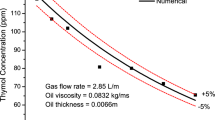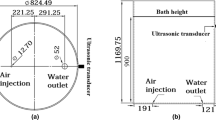Abstract
Physical and mathematical modeling of energy dissipation phenomena in a gas-stirred ladle with, and without, an overlying second-phase liquid have been carried out at relatively low gas flow rate and specific energy input rate. Data from the literature are applied to infer the extent of energy dissipation caused by various mechanisms. An analysis reveals that bubble slippage and friction at the vessel walls dominate energy dissipation in such systems, each contributing roughly one third of the input energy. The remainder is dissipated because of turbulence in the bulk of the liquid, the formation of a spout, and interactions between the upper phase and the bulk liquid when an overlying liquid is present. Remarkably, the overlying liquid despite its small volume (~3 pct to 13 pct of the bulk), is found to dissipate about 10 pct of input energy. To understand the way the total input energy is dissipated via the overlying liquid, flow and mixing studies were carried out with different types of upper phase liquids. Tracer dispersion studies conducted with Petroleum ether as the overlying liquid show reasonably intense flow within the upper phase with no noticeable entrainment around the spout. In contrast, a thick layer of highly viscous upper phase liquid such as mustard oil shows extensive deformation of the upper phase around the spout, but no discernable motion within. However, remarkably, the thickness of the upper phase rather than its physical properties was found to influence bath hydrodynamics and mixing most significantly. A mechanism based on the rerouting of the surfacing plume and the attendant reversal of flow in the vicinity of the spout is advocated to explain energy dissipation caused by the overlying liquid. This finding is rationalized with our experimental results on composition adjustment with sealed argon bubbling (CAS) alloy addition procedures reported more than two decades ago, wherein flow reversal caused by the baffle in the immediate vicinity of the surfacing plume was shown to cause significant energy dissipation, leading to much sluggish flow and slower mixing in the bulk of the liquid, in comparison with an equivalent unbaffled situation.









Similar content being viewed by others
Notes
Note: “thin” and “thick” slag layers are relative terms. Under ladle metallurgy steelmaking conditions, depending on the size of the ladle and the objective of the refining operations, the volume of slag (and hence its thickness) can vary appreciably. Data collected from several industrial size vessels (44 to 185 tonnes) indicate slag layer thickness varying between 1 pct and 7 pct of the bath depth. The thickness of the upper phase liquid considered in this study ranges between 3 pct and 13 pct of the bath depth and is, therefore, regarded on a relative scale as a thick slag.
Note: Typically, the top of the slag layer is crusty because of pronounced heat loss, whereas the region underneath is likely to remain molten.
Note: The eye area becomes progressively smaller as the slag layer thickness increases, making the spout less and less visible. However, within the range of the experimental conditions considered in this study, the spout was never completely submerged under the slag layer.
Abbreviations
- A eye :
-
Exposed slag eye area, m2
- C :
-
Average intensity of turbulence in the bath
- C :
-
Universal dissipation rate constant
- D :
-
Diameter of the vessel, m
- D :
-
Diameter of an equivalent volume spherical cap bubble, m
- E :
-
Total rate of energy input to the system, W
- Gg :
-
Acceleration caused by gravity, m/s2
- L :
-
Depth of liquid in the vessel, m
- ∆L :
-
Slag layer thickness, m
- R :
-
Radius of the vessel, m
- \( \overline{U} \) :
-
Mean speed of bath recirculation, m/s
- U B :
-
Rise velocity of bubble, m/s
- U P :
-
Plume rise velocity, m/s
- U s :
-
Slip velocity, m/s
- U t :
-
Terminal rise velocity of a characteristic spherical cap bubble, m/s
- Q :
-
Gas flow rate corrected to mean height and temperature of the liquid, m3/s
- β :
-
Fractional depth of lance submergence
- ε i :
-
Rate of energy input, W
- ε m :
-
Specific rate of energy input, W/kg
- ρ b :
-
Density of bulk (lower phase), kg/m3
- ρ s :
-
Density of slag (upper phase), kg/m3
- ρ L :
-
Density of liquid, kg/m3
- ∆ρ :
-
Density differential between metal and slag, kg/m3
- η :
-
Dissipation coefficient
References
D. Mazumdar and R.I.L. Guthrie: ISIJ Int., 1995, vol. 35, no. 1, pp. 1-20.
D. Mazumdar and J.W. Evans: ISIJ Int., 2004, vol. 44, pp. 447-61
S.H. Kim and R.J. Fruehan: Metall. Trans. B, 1987, vol. 18B, pp. 381-90.
S.H. Kim, R.J. Fruehan, and R.I.L. Guthrie: Proc. Steelmaking Conf., 1986, pp. 107–18.
Q. Ying, L. Yun, and L. Lui: Proc. SCANINJECT III, MEFOS and Jernkontoret, Lulea, Sweden, 1983, pp. 21.1-16.
O. Haida and J.K. Brimacombe: Proc. SCANINJECT III, MEFOS and Jernkontoret, Lulea, Sweden, 1983, 1983, pp. 5.1-17.
J.W. Han, S.H. Heo, D.H. Kam, B.D. You, J.J. Pak, and H.S. Song: ISIJ Int, 2001, vol. 41, pp. 1165-73.
M. Iguchi, K. Takahashi, H. Kawabata, K. Sasaki, S. Yokoya, and H. Kiuchi: ISIJ Int., 1998, vol. 38, pp.1080-85.
M. Iguchi, K. Takahashi, O.J. Illegbussi, M.Sano, and H. Kiuchi: ISIJ Int., 1998, vol. 38, pp. 1032-34.
S. Yamashita, K. Miyamoto, M. Iguchi, and M. Zeze: ISIJ Int., 2003, vol. 43, pp. 1858-60.
H. Nakajima, D. Mazumdar, and R.I.L. Guthrie: Tetsu to Hagane, 1987, pp. S949.
K.K. Krishnapisharody and G.A. Irons: Metall. Mater. Trans. B, 2006, vol. 37B, pp. 763-72.
D. Mazumdar, H. Nakajima, and R.I.L. Guthrie: Metall. Trans. B, 1988, vol. 19B, pp. 507-11.
Y. Kishimoto, Y. Sheng, G.A. Irons and J.S. Chang: ISIJ Int.,1999, vol. 39, pp. 113-22.
Y. Sahai and R.I.L. Guthrie: Metall. Trans. B, 1982, vol. 13B, pp. 193-202.
B.E. Launder and D.B. Spalding: Comput. Meth. Appl. Mech. Eng., 1974, vol. 3, pp. 269-89.
D. Mazumdar: Metall. Trans. B, 1988, vol. 20B, pp. 967-9.
M. Sano and K. Mori: Proc., SCANINJECT III, MEFOS and JERNKONTORET, Lulea, Sweden, 1983, pp.6.1-6.17.
Y. Sheng and G.A. Irons: Metall. Trans. B, 1992, vol. 23B, pp. 779-87.
J. Szekely: Fluid Flow Phenomena in Metals Processing, Academic Press, London, UK, 1980.
J.F. Davidson and D. Harrison: Fluidized Particles, Cambridge University Press, New York, NY, 1963.
D. Mazumdar: Metall. Mater. Trans. B, 2002, vol. 33B, pp. 937-41.
K.K. Krishnapisharody and G.A. Irons: Metall. Mater. Trans. B, 2007, vol. 38B, pp. 367-75.
T.C. Hsiao, T. Lehner, and B. Kjellburgh: Scand. J. Metall., 1980, vol. 9, pp. 105-10.
D. Mazumdar, D. Steingart, C. Sybert, and J.W. Evans: ISIJ Int., 2003, vol. 43, pp. 132-4
M. Hirasawa, K. Mori, M. Sano, Y. Shimatani, and Y. Okazaki: Trans. ISIJ, 1987, vol. 27, pp. 283-90.
D. Mazumdar and R.I.L. Guthrie: Ironmaking Steelmaking, 1985, vol. 12, no. 6, pp. 256-64.
D. Mazumdar and R.I.L. Guthrie: Appl. Math. Model., 1986, vol. 10, no. 1, pp. 25-32.
D. Verhelst: Masters Thesis, McGill University, Montreal, Canada, 1991.
D. Mazumdar and R.I.L. Guthrie: Metall. Trans. B, 1986, vol. 17B, pp. 725-33.
Y. Konezawa and K. Schwerdfeger: Metall. Mater. Trans. B, 1999, vol. 30B, pp. 411-9.
S. Patil, D. Satish, M. Peranadhanathan, and D. Mazumdar: ISIJ Int., in press.
Acknowledgment
This work is a celebration of 25 years of friendship between the authors. The authors wish to acknowledge gratefully Mr. Pranay Das for providing experimental data from his B. Tech. thesis, which are summarized in Table VII.
Author information
Authors and Affiliations
Corresponding author
Additional information
Manuscript submitted October 2, 2009.
Rights and permissions
About this article
Cite this article
Mazumdar, D., Guthrie, R.I. Modeling Energy Dissipation in Slag-Covered Steel Baths in Steelmaking Ladles. Metall Mater Trans B 41, 976–989 (2010). https://doi.org/10.1007/s11663-010-9389-x
Published:
Issue Date:
DOI: https://doi.org/10.1007/s11663-010-9389-x




